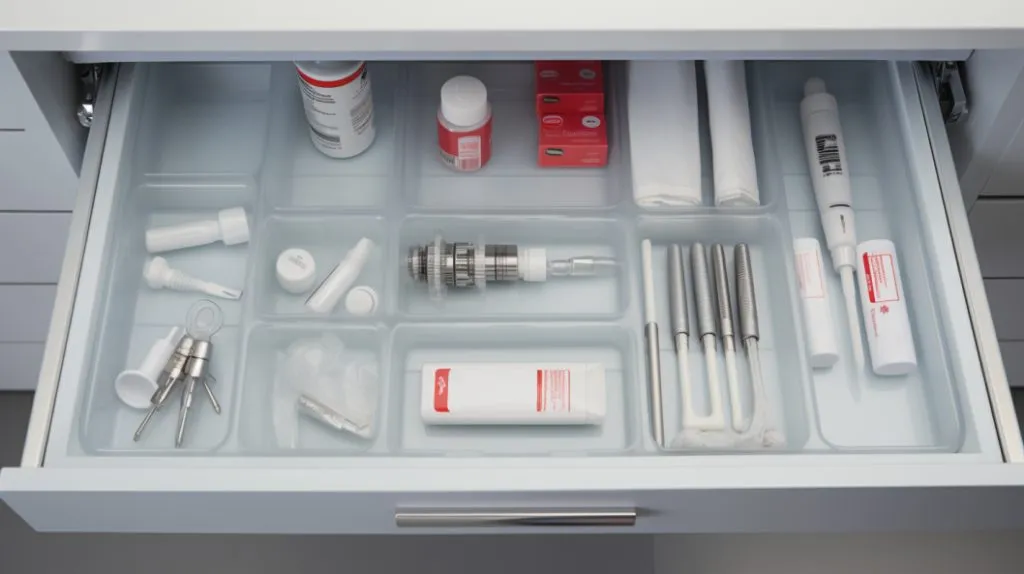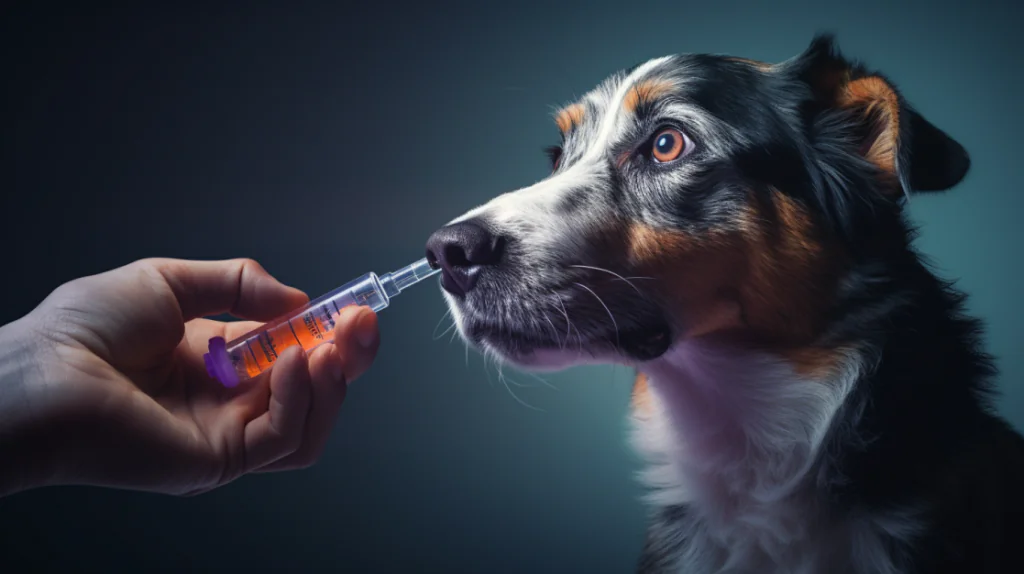Table of Contents
You may not realize it, but a hidden lifesaver for your furry companion is tucked away in your drawer. Dog diabetes syringes, often overlooked and underestimated, play a crucial role in managing your dog’s health. It’s ironic how such a small, seemingly insignificant tool can hold the key to your pet’s well-being.
But be aware of its size; these syringes are far from ordinary. In dog diabetes syringes, proper insulin administration is of utmost importance. These syringes are specifically designed to ensure accurate dosages, allowing you to navigate the complexities of this condition confidently. From handling and storage to measuring insulin dosage, this article will guide you through the ins and outs of using dog diabetes syringes effectively.
Making injections easier is a top priority, and we’ve got you covered with helpful tips and techniques. Safety precautions and proper disposal are essential aspects that cannot be overlooked. By understanding the critical role of diabetes syringes in overall diabetes management, you can empower yourself to be the best advocate for your four-legged friend.
So, let’s unlock the potential of that lifesaver in your drawer and embark on a journey toward a healthier, happier life for your beloved pet.
Key Takeaways Of Dog Diabetes Syringes
- Proper insulin administration is crucial for managing dog diabetes.
- Different dog diabetes syringes, including insulin pens, are available for use.
- Tips and techniques can make injections easier for the dog and the owner.
- Regular veterinary check-ups are important for monitoring and adjusting treatment for diabetic dogs.
The Importance of Proper Insulin Administration
Proper insulin administration is crucial for effectively managing canine diabetes. Managing diabetes in dogs involves daily insulin injections to help regulate their blood sugar levels. Dog diabetes syringes, such as u-40 insulin syringes, are specifically designed for the correct dose and administration of insulin. Deviating from the schedule can lead to fluctuating glucose levels, seriously affecting your dog’s health.
Additionally, improper insulin administration can pose potential risks. If the doses of insulin is too high, it can result in hypoglycemia, causing weakness, seizures, or even coma. On the other hand, if the dose is too low, it may fail to control blood sugar adequately, leading to hyperglycemia and its associated complications. Therefore, it’s essential to follow the prescribed insulin regimen carefully.
Now, let’s explore the different types of dog diabetes syringes available to make this process easier for you and your furry companion.
Types of Insulin and Syringes Used for Injections

When managing diabetes in dogs, choosing the right insulin and syringes for injections is crucial. Here are some key types of insulin and syringes commonly used for dogs:
1. Porcine Insulin Zinc Suspension (PZI): This type of insulin is derived from pigs and provides a longer duration of action, making it ideal for dogs with diabetes mellitus.
2. Human Insulin: Human insulin, available as regular or fast-acting insulin, can also be used for dogs. It helps regulate blood sugar levels effectively.
3. Syringe Types: U-40 syringes and U-100 insulin syringes are most commonly used for dogs. The syringe-type should match the concentration of insulin being used.
Choosing the right syringe size is important for accurate dosing. A smaller syringe size, like a 1cc (cubic centimeter) or 0.5cc syringe, is typically recommended for small to medium-sized dogs, while larger dogs may require a larger syringe size.
Pet owners should always follow the veterinarian’s instructions for the correct dosage and administration of insulin. Regularly monitoring the dog’s blood glucose levels and maintaining a healthy diet and lifestyle are essential for effective diabetic care.
Proper Syringe Handling and Storage

When handling and storing syringes for insulin administration, it’s crucial to follow the correct procedures to ensure the potency and safety of the medication. Here are three important things to keep in mind:
- Syringe disposal: After each use, properly disposing of the syringe in a sharps container is important. This helps prevent accidental needle sticks and ensures safe removal.
- Syringe maintenance: To maintain the syringe’s effectiveness, cleaning it properly after each use is important. This involves rinsing it with warm, soapy water and allowing it to air dry. Avoid using alcohol or harsh chemicals, as they can damage the syringe.
- Proper storage: Store your syringes in a cool, dry place away from direct sunlight and extreme temperatures. This helps maintain the potency of the insulin and prevents any contamination.
How to Measure Insulin Dosage

To accurately measure your insulin dosage, use the markings on the syringe and consult your veterinarian for specific instructions.
Measuring insulin accurately is crucial for maintaining your dog’s health. The syringe will have markings that indicate the units of insulin, typically ranging from 0 to 100. Pull the plunger back to the desired unit on the syringe to measure the dosage. It’s important to be precise and avoid any air bubbles in the syringe, as they can affect the accuracy of the dosage.
Administering Insulin Injections

Administering insulin injections can be a simple and effective way to manage your furry friend’s diabetes. One popular option is an insulin pen, a convenient and accurate tool for administering medication. The insulin pen allows precise dosage measurements and easy injection into your dog’s skin. It’s important to follow the instructions provided by your veterinarian to ensure proper usage of the pen.
Monitoring Blood Glucose Levels
Now that you’re familiar with administering insulin injections to your dog, it’s important to understand the significance of monitoring their blood glucose levels. Regular monitoring is crucial in managing your dog’s diabetes and ensuring its health and well-being.
By monitoring their blood glucose levels, you can determine if their insulin dosage is appropriate and make any necessary adjustments. This involves using a blood glucose monitoring system to accurately measure their blood sugar levels. This process allows you to track their insulin response and identify patterns or trends in their blood glucose levels.
Common Challenges and Troubleshooting
Confronting the hurdles and finding solutions is like embarking on a maze where every twist and turn brings a new challenge in managing your furry friend’s condition.
When it comes to monitoring your dog’s blood glucose levels, there are common challenges that you may encounter. One common challenge is obtaining a blood sample. Getting enough blood for testing can be difficult, especially if your dog is not cooperative. In such cases, you can gently massage the area or use a warm compress to help increase blood flow.
Tips for Making Injections Easier

Here are some tips for managing needle anxiety and making injections easier:
- Relaxation techniques: Before injecting, create a calm environment by dimming the lights, playing soothing music, and using gentle touch to help your dog relax.
- Treat rewards: Associate injections with positive experiences by providing tasty treats before and after the injection. This will help distract your dog and create a positive association with the process.
- Proper technique: Ensure you use the correct needle size and inject at the recommended angle and depth. This will minimize discomfort and make the process smoother for you and your dog.
By following these tips, you can make injections a more comfortable experience for your furry friend.
Safety Precautions and Disposal
Ensuring the safety of your furry friend is crucial when it comes to handling injections and disposing of waste materials. When administering insulin to your dog, taking certain safety precautions is important.
First, always wash your hands thoroughly before and after handling the syringe. This helps to prevent any potential contamination. Also, properly clean and disinfect the injection site before each injection. This reduces the risk of infection.
Regarding syringe disposal, it’s important to discard used syringes safely. Use a puncture-proof sharps container to prevent accidental injuries. Never throw used needles in the regular trash or recycling bin. Proper disposal helps to protect both humans and animals from potential harm.
By following these safety precautions and practicing proper syringe disposal, you can ensure the well-being of your furry companion.
Moving on to the next topic, let’s discuss the role of diabetes syringes in overall diabetes management.
The Role of Diabetes Syringes in Overall Diabetes Management
When it comes to managing diabetes, diabetes syringes play a vital role in keeping your furry friend healthy and happy. These syringes are designed to administer insulin accurately and safely, ensuring your dog receives the correct dosage. By using diabetes syringes, you can have peace of mind knowing that you’re effectively managing your dog’s diabetes.
A key benefit of diabetes education is understanding the role of diet in managing dog diabetes. With the guidance of a veterinarian or a certified dog nutritionist, you can create a customized diet plan that meets your dog’s nutritional needs while helping to regulate their blood sugar levels. Additionally, diabetes education can provide valuable information on monitoring your dog’s glucose levels, recognizing signs of high or low blood sugar, and adjusting insulin doses as needed.
Resources and Support for Dog Owners with Diabetic Pets
If you are a dog owner with a diabetic pet, you understand the unique challenges of managing their condition. Luckily, resources and support are available to help you navigate this journey and provide the best care for your furry friend.
One valuable resource is the dog diabetes support community. These communities bring together pet owners going through similar experiences, allowing you to share advice, ask questions, and find comfort in knowing you are not alone. Additionally, there are online forums, websites, and social media groups dedicated to diabetic pet care, where you can find information on diet, exercise, monitoring blood sugar levels, and administering insulin.
To help you easily explore these resources, here is a table summarizing three popular dog diabetes support groups and websites:
| Support Group/Website | Description | Benefits |
|---|---|---|
| Diabetic Dogs Forum | An online forum where dog owners can connect and share experiences related to diabetic pet care. | Access to a supportive community and a wealth of information. |
| Canine Diabetes Support and Information | A website providing comprehensive information on canine diabetes, including diet, treatment options, and monitoring techniques. | A one-stop resource for all your diabetic pet care needs. |
| Diabetic Pet Management | A social media group dedicated to helping pet owners manage their diabetic pets, offering tips, advice, and a platform for discussion. | Real-time support and a platform to connect with other pet owners facing similar challenges. |
By taking advantage of these resources and support systems, you can provide the best possible care for your diabetic dog.
Frequently Asked Questions
Can dog diabetes syringes be used for other purposes?
Yes, dog diabetes syringes can be used for cats. However, it is important to note that insulin pens have advantages for dogs, such as ease of use and accurate dosing.
How often should dog diabetes syringes be replaced?
Dog diabetes syringes are not safe for human use. They are specifically designed for dogs and may not deliver insulin accurately for humans. To properly dispose of them, place them in a sharps container and follow local guidelines for disposal.
Can dog diabetes syringes be reused?
Dog diabetes syringes should never be reused for safety reasons. Properly clean them after each use to prevent infections. Remember, “An ounce of prevention is worth a pound of cure.”
Are there any alternative methods for administering insulin to dogs?
There are alternative insulin delivery methods for dogs, such as insulin pens. Using insulin pens for dogs has several benefits, including ease of use, accurate dosing, and reduced risk of contamination.
Can dog diabetes syringes be purchased over the counter, or are they only available through a veterinarian?
Yes, dog diabetes syringes can be purchased over the counter. Despite concerns about affordability and convenience, many pet stores offer these syringes without a prescription. However, it’s still recommended to consult a veterinarian for proper usage and dosage.
Conclusion
In conclusion, dog diabetes syringes are crucial in managing your furry friend’s health. Properly administering insulin using these syringes ensures that your dog receives the correct dosage and stays on track with their diabetes treatment.
Did you know that approximately 1 in every 160 dogs develop diabetes? It’s a common condition that requires careful attention, but with the right tools and knowledge, you can help your dog live a happy and healthy life. Always consult your veterinarian for guidance and support in managing your dog’s diabetes.
Reader Advisory: This article, aimed at informational purposes, does not replace professional veterinary advice. While we aim for accuracy, we make no guarantees regarding the completeness or reliability of our content. Always consult a veterinarian before altering your dog’s diet or nutrition.




